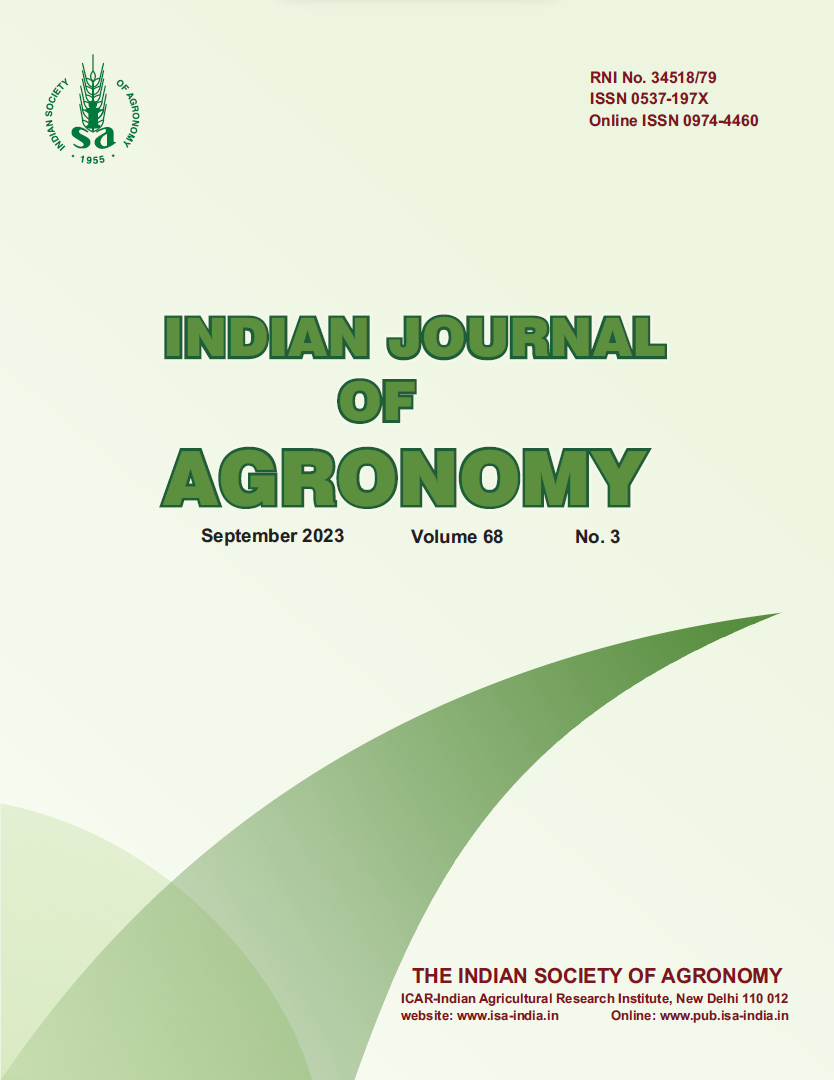Production potential of pulse-and oilseed-based climate-resilient alternative cropping systems for diversification of rice (Oryza sativa)–wheat (Triticum aestivum) in North-western Indo-Gangetic Plains
DOI:
https://doi.org/10.59797/ija.v68i3.2802Keywords:
Apparent water productivity, Diversification, Economics, Production efficiency, Pulse-based cropping systems, Rice-equivalent yield, Sustainable-yield indexAbstract
A field experiment was conducted during 2016–17, 2017–18 and 2018–19 at the Punjab Agrcultural University, Ludhiana, India, to evaluate the economic feasibility of pulse-and oilseed-based new alternative cropping systems in comparison to rice (Oryza sativa L.)–wheat (Triticum aestivum L.) cropping system. Among the 10 cropping systems evaluated in a randomized block design on a loamy sand soil, the highest rice-equivalent yield (23.2 t/ha) was obtained in groundnut (Arachis hypogaea L.)–garden peas (Pisum sativum L.)–sunflower (Helianthus annuus L.) with highest sustainable- yield index (0.81), followed by groundnut –garden peas– spring maize (Zea mays L.) (22.5 t/ha) as significantly better than rest of the cropping systems. In comparison to conventional rice–wheat system, higher net returns as well as relative economic efficiency were recorded in 4 cropping systems, viz. groundnut–garden peas–sunflower, groundnut–garden peas–spring maize, rice–wheat–summer mungbean [Vigna radiata (L.) R. Wilczek] and mungbean–toria [Brassica rapa subsp. dichotoma (Roxb.) Hanelt]–sunflower. Maximum apparent water productivity was observed in pigeonpea [Cajanus cajan (L.) Millsp.]–chickpea (Cicer arietinum L.)– summer mungbean, whereas the maximum nutrient-use productivity was observed in groundnut–garden peas– sunflower, followed by pigeonpea–chickpea–summer mungbean and the least values were recorded in rice–wheat system. Thus, resource-conserving biointensive cropping systems, viz. groundnut–garden peas–sunflower, groundnut–garden peas–spring maize, rice–wheat–summer mungbean and mungbean–toria–sunflower can be adopted for higher productivity, profitability and sustainability.
References
Ali, M. and Gupta, S. 2012. Carrying capacity of Indian agriculture: pulse crops. Current Science 102(6): 874–881.
Gan, Y., Hamel, C., O’ Donovan, J.T., Cutforth, H., Zentner, R.P., Campbell, C.A., Niu, Y. and Poppy, L. 2015. Diversifying crop rotations with pulses enhances system productivity. Scientific Reports 5: 14625, pp. 1–14.
http://www.fao.org/india/fao-in-india/india-at-a-glance/en/accessed on dated 20 January, 2023.
Jacob, D., Mathew, T., Jacob, J., Rani, B. and Sukumari, P. 2016. On-farm farmers’ participatory evaluation of intensification of rice (Oryza sativa)–rice–fallow system with vegetables in summer under humid tropical irrigated lowlands. Indian Journal of Agronomy 61(3): 281–285.
Kachroo, D., Thakur, N. P., Kour, M., Kumar, P., Sharma, R. and Khajuria, V. 2014. Diversification of rice (Oryza sativa)- based cropping system for enhancing productivity and employment. Indian Journal of Agronomy 59(1): 21–25.
Kaur, J. and Palli, S.S. 2021. Alternative cropping systems of rice– wheat involving faboid legume crops for crop diversification and sustainability (In:) Sustainable Production of Pulses in Diverse Agro-ecosystems, vol. 1. Strategies for Enhancing Production, pp. 15–31. Kumar, Narendra et al. (Eds). Scientific Publisher, Jodhpur, Rajasthan, India.
Kaur, R., Shivay, Y. S., Singh, G., Virk, H. K., Sen, S. and Rajni. 2018. Increasing area under pulses and soil quality enhancement in pulse-based cropping systems-retrospect and prospects. Indian Journal of Agricultural Sciences 88(1): 10–21.
Mal, T., Walia, S. S. and Saini, K. S. 2018. Productivity and economics of different cropping systems in relation to tillage, mulching and fertilizer management practices in north-western Indo-Gangetic Plains of India. Indian Journal of Agricultural Sciences 88(2): 216–221.
Patel, M. and Jat, A.L. 2022. Response of Indian mustard (Brassica juncea) to varying spacing and transplanting in north Gujarat region. Indian Journal of Agronomy 67(1): 101–104.
Patel, S., Rathore, S.S., Shekhawat, K., Rameti, Singh, V.K., Singh, R.K., Babu, S. and Iquebal, M.A. 2022. Sustaining Indian mustard (Brassica juncea) productivity and soil health through varietal diversification under diverse production system. Indian Journal of Agronomy 67(1): 105–107.
PAU, Ludhiana. 2021. Statistics of Punjab Agriculture. 58 p. Punjab Agricultural University, Ludhiana, India.
Prasad, D., Rana, D. S., Babu, S., Choudhary, A. K. and Rajpoot, S. 2016. Influence of tillage practices and crop diversification on productivity and soil health in maize (Zea mays)/soybean (Glycine max)-based cropping systems. Indian Journal of Agricultural Sciences 86(1): 96–102.
Saini, K.S., Kaur, J., Singh, T., Chahal, T.S. and Manhas, S.S. 2020. Productivity, economics and energetics of potato (Solanum tuberosum)-based systems as an alternative to rice (Oryza sativa)–wheat (Triticum aestivum) in Doaba region of Punjab. Indian Journal of Agronomy 65(1): 125–129.
Singh, G., Ram, H., Sekhon, H. S., Aggarwal, N., Kumar, M., Kaur, P., Kaur, J. and Sharma, P. 2011. Effect of nitrogen and phosphorus application on productivity of summer mungbean sown after wheat. Journal of Food Legumes 24(4): 327–329.
Stagnari, F., Maggio, A., Galieni, A. and Pisante, M. 2017. Multiple benefits of legumes for agriculture sustainability: An overview. Chemical and Biological Technologies in Agriculture 4(2): 1–13.
www.indiastat.com. 2022. Per capita availability and import of pulses and edible oils in India. http//www.indiastat.com.






